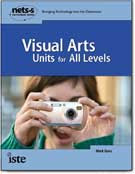ISTE 2011 – the annual conference of the International Society for Technology in Education (ISTE) was held this year in Philadelphia. There was a fair amount of technology oriented Arts Education activity in evidence at the conference.
I gave a workshop/lecture titled
“Technology Makes Art Easy for Every Teacher in Every Classroom“ which was well received. I got some worthwhile, some interesting and eye opening, and some appreciative feedback from participants. For the workshop content and more information and resources on this vital subject, please check out the following links:
General Link -
Technology Makes Art Easy for Every Teacher in Every Classroom
Workshop/Lecture Description – “Visual Art has the potential to greatly enrich the educational experience of all students. However, the shortage of trained Art Teachers, the cost and inconvenience of traditional art materials and art classrooms, and fears and confusion about the need for talent have made art something that fewer and fewer students benefit from at school. This session will demonstrate how informed technology use can support and encourage all teachers to make art part of their instructional repertoire, turn every classroom into an art room, and every student an adept maker of art…”
For full description go to > http://www.isteconference.org/ISTE/2011/program/search_results_details.php?sessionid=60644244&selection_id=69577836&rownumber=1&max=1&gopage=
Workshop/Lecture Handout – This is the PowerPoint presentation that guided my oral presentation…
http://www.slideshare.net/markgura/tech-makesarteasy4everyteachergura
As a conference offering with high potential impact, the session was recorded as video…
Workshop/Video (scroll down to mid-page) – http://www.isteconference.org/ISTE/2011/program/search_results_details.php?sessionid=60644244&selection_id=69577836&rownumber=1&max=1&gopage=
Alas, while the session was well received, its essential message may have fallen through the cracks. The key idea is that technology has changed the equation and made it possible for all teachers (every subject area) to now make Visual Art part of what they do with their students. However, as was easy to predict, the session drew attendance primarily of “Art Teachers”, a group who find my idea interesting, but who are not the rank and file generalist classroom teachers for whom the message is intended to have greatest impact.
There were also several
Poster Sessions given by accomplished art educator colleagues that I want to list recommend here:
1)
Craig Roland’s poster session was most interesting and all interested in Art Teaching in the age of near ubiquitous classroom technology should be aware of and visit Craig’s powerful Art Education 2.0 online resource:
Creating Global Connections with Art and Technology
Digital-Age Teaching & Learning: Arts
Craig Roland, Davis Publications with Robb Sandagata
Learn how art teachers are using social media and digital tools combined with the power of image making to build global learning opportunities for their students.
Craig’s very powerful web resource for educators:
http://arted20.ning.com/
and
2) Deborah Greh’s poster session offered valuable ideas about approaches and resources for teaching art with classroom technology.
Digital Age Tools for Art Teachers
Digital-Age Teaching & Learning: Arts
Deborah Greh, St Johns University with Susan Bivona.
Find out about the 21st Century Skills Map for the arts as well as Web resources specifically for art specialists.
Deborah was kind enough to email me the following link which leads to numerous, valuable resources:
http://sites.google.com/site/artatiste/
The many vendor displays and ‘digital playground’ hands-on exhibits for Visual , related resources and approaches throughout the conference – as well the 2 poster sessions and the follow-up links provided by Craig, Deborah, and other colleagues show they very impressive amount of available items for Visual Arts Educators. However, beyond the inspiration they inspire in me, I also see the need for a serious conversation about What’s Meaningful in Visual Arts Instruction CURRENTLY. Alas, there seems to be so much effort and interest in getting kids doing things in the area of visual arts, that the guiding questions of why Visual Art do and What in Visual Art is truly worth doing? Have largely fallen by the wayside. For all the good stuff out there, there persists a stream of what I see as meaningless “visual effect oriented, superficial activities”… think of digital coloring books and “Instant Art” of every conceivable variety. I hope to get a broad-based conversation going about this sometime soon!!! We really need it…



